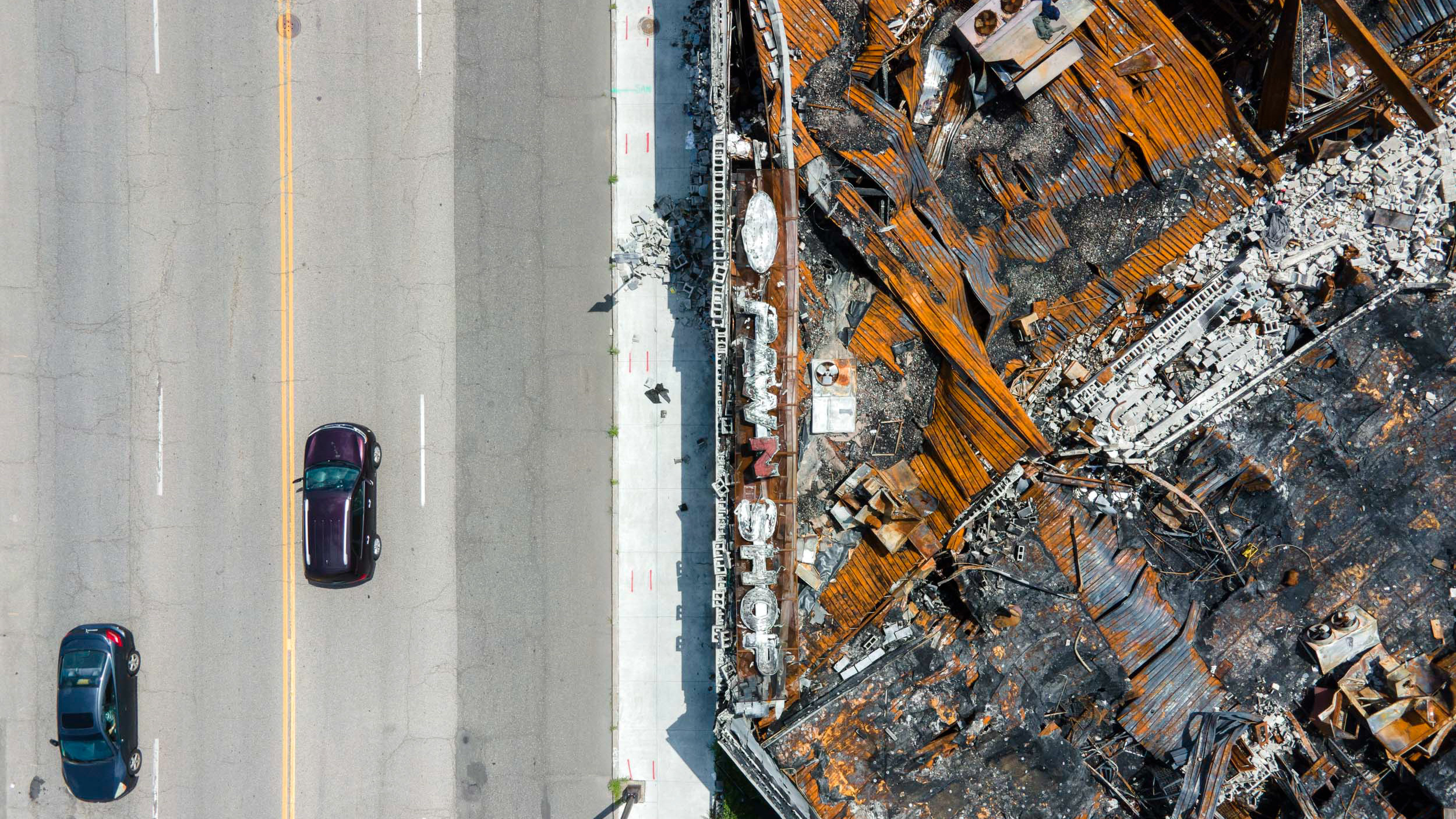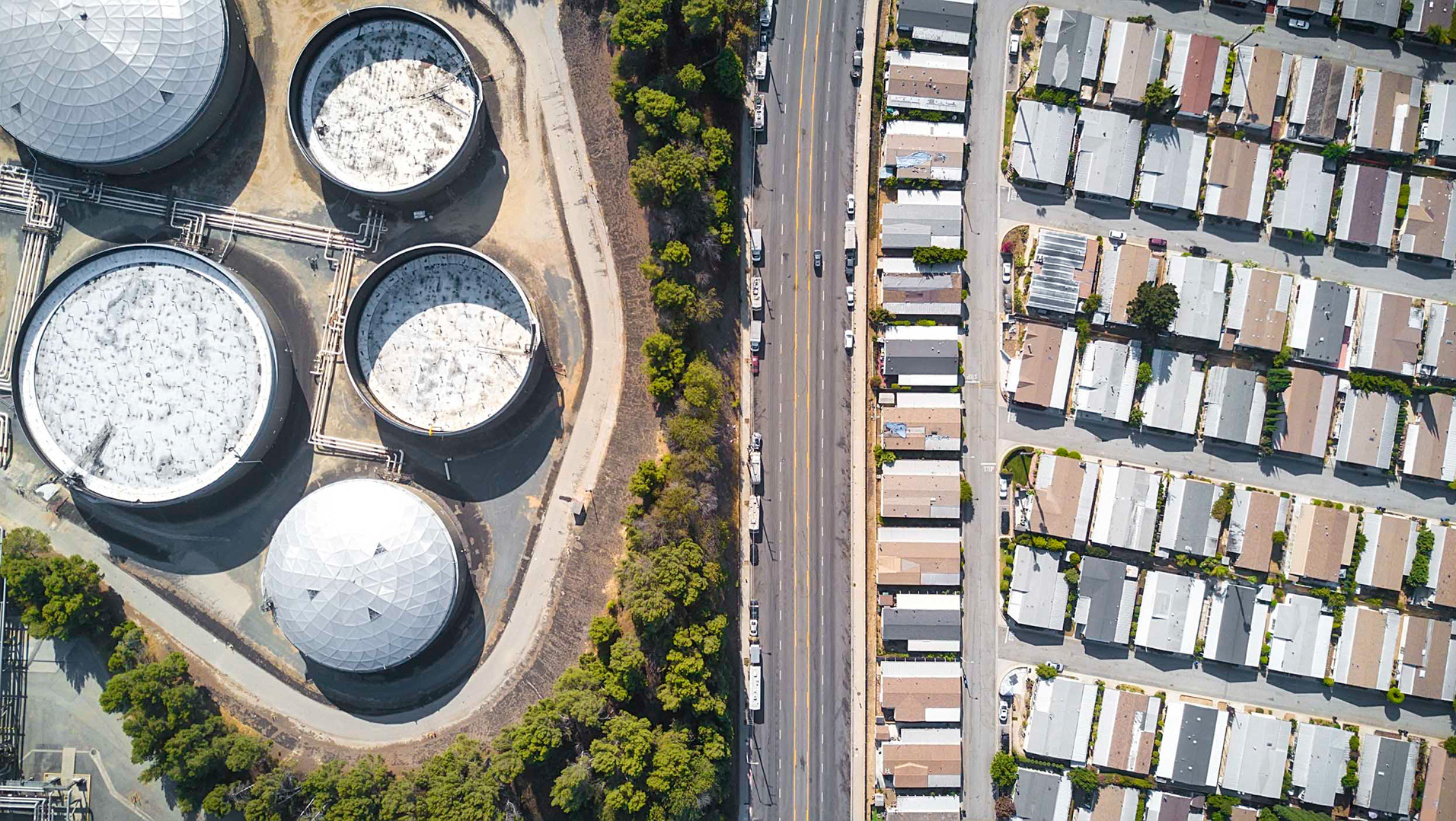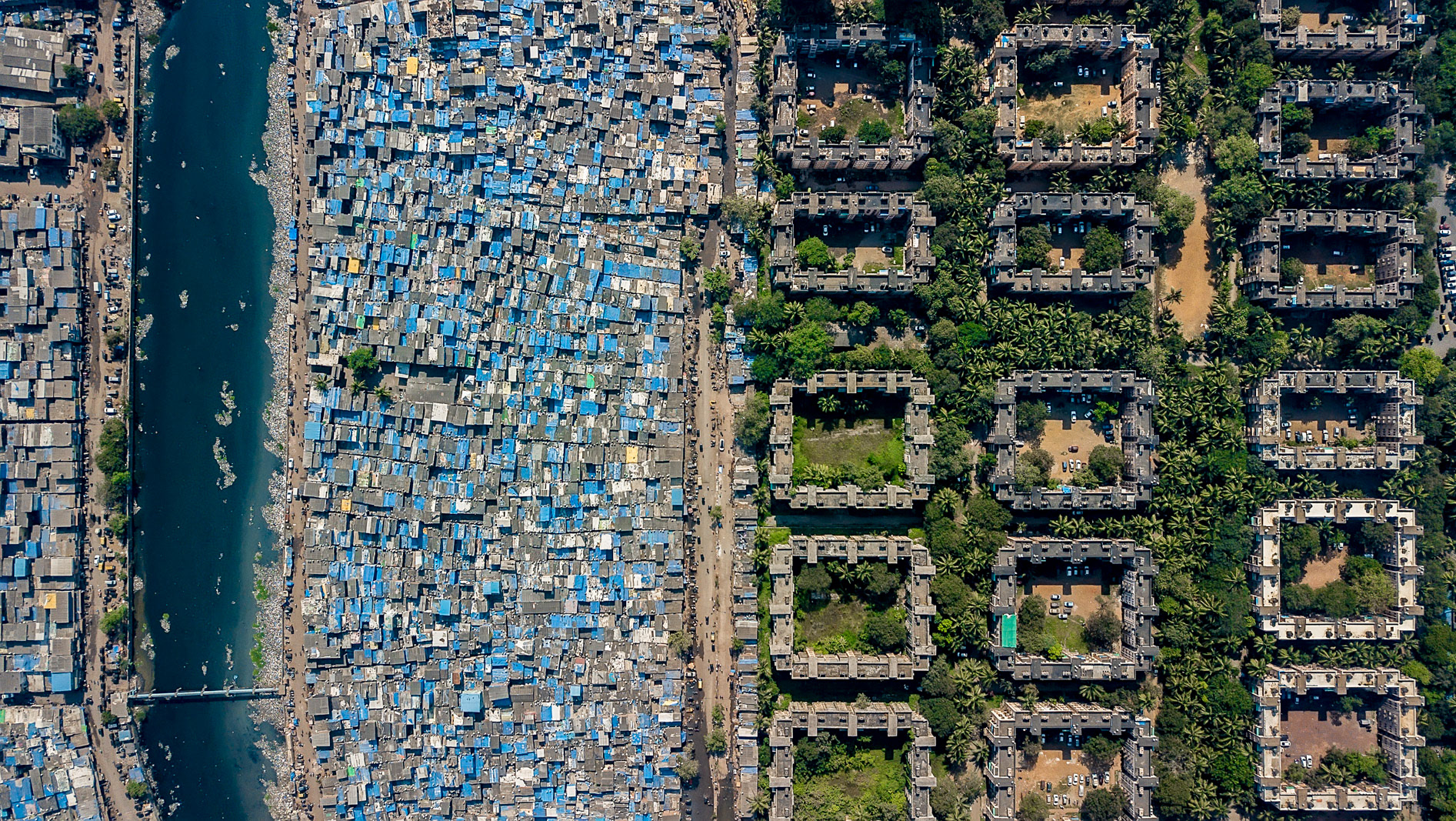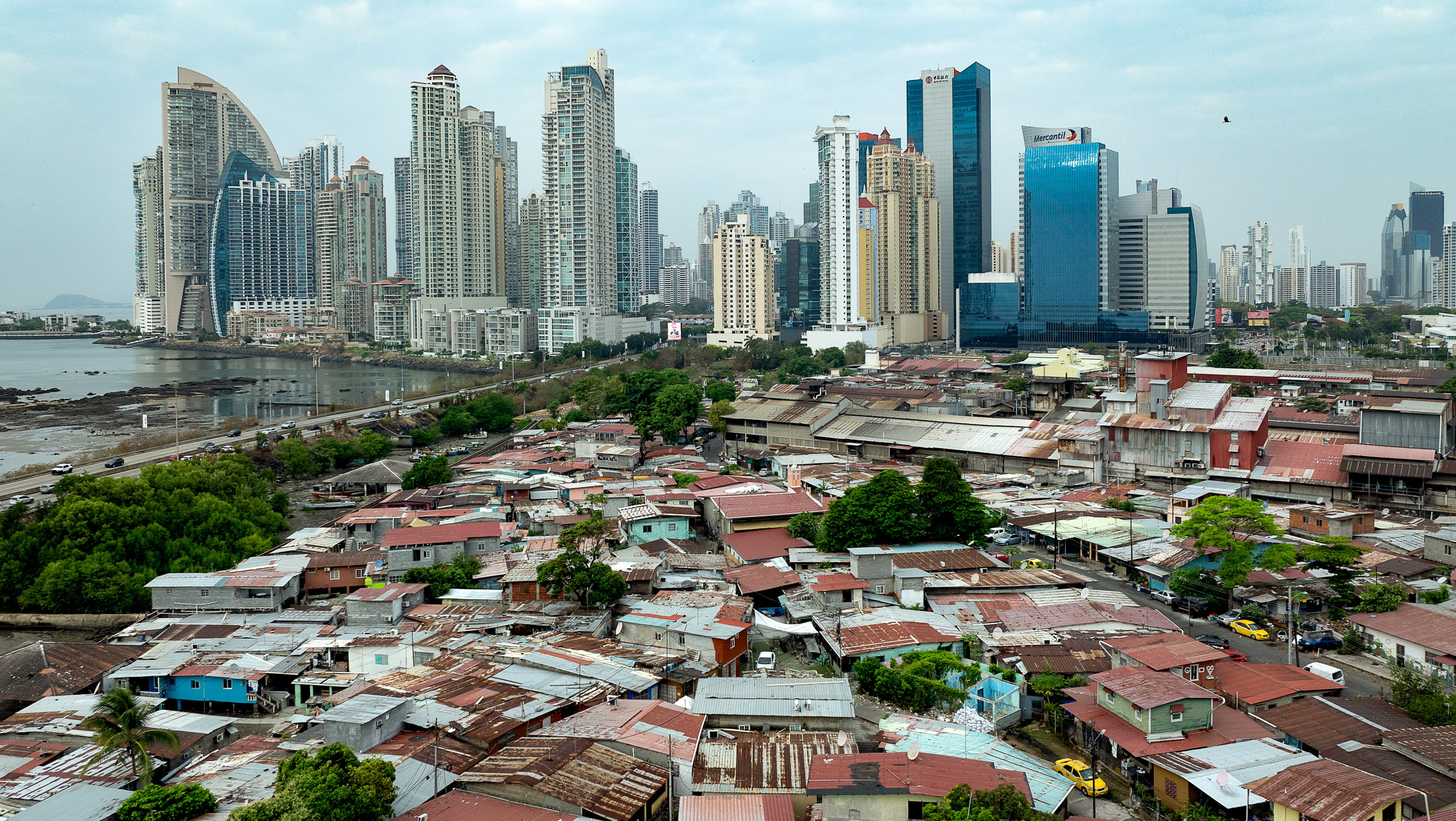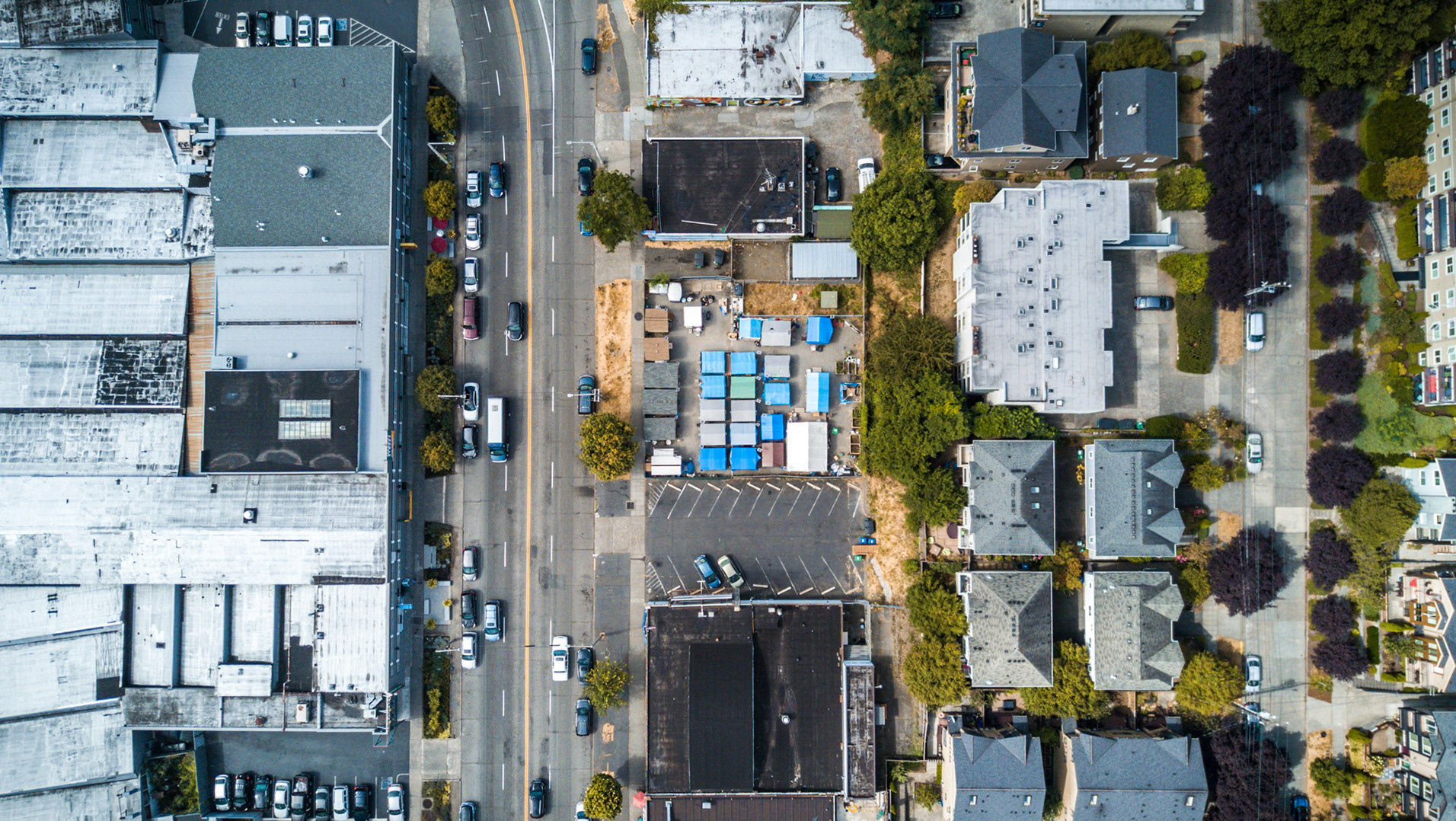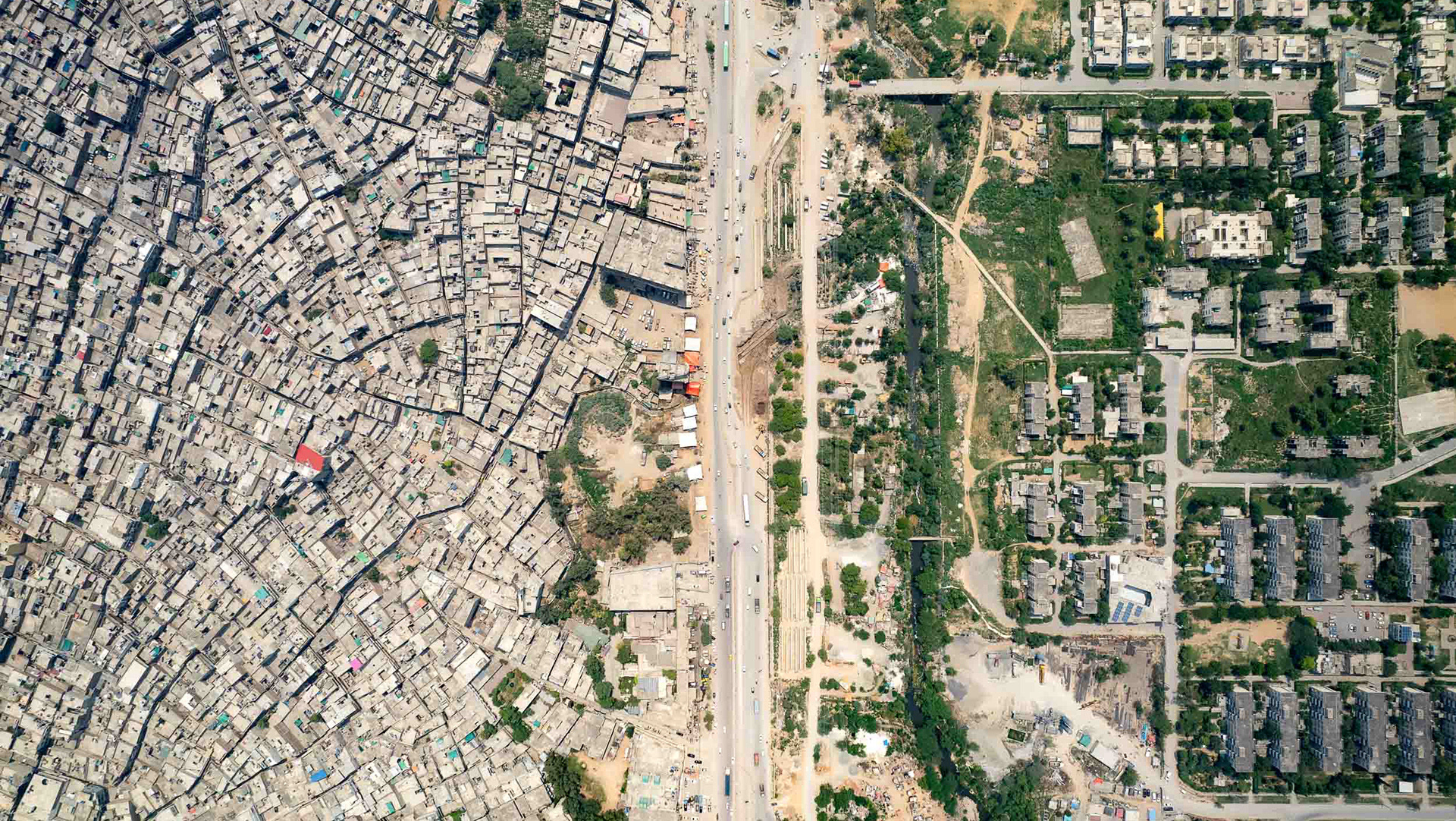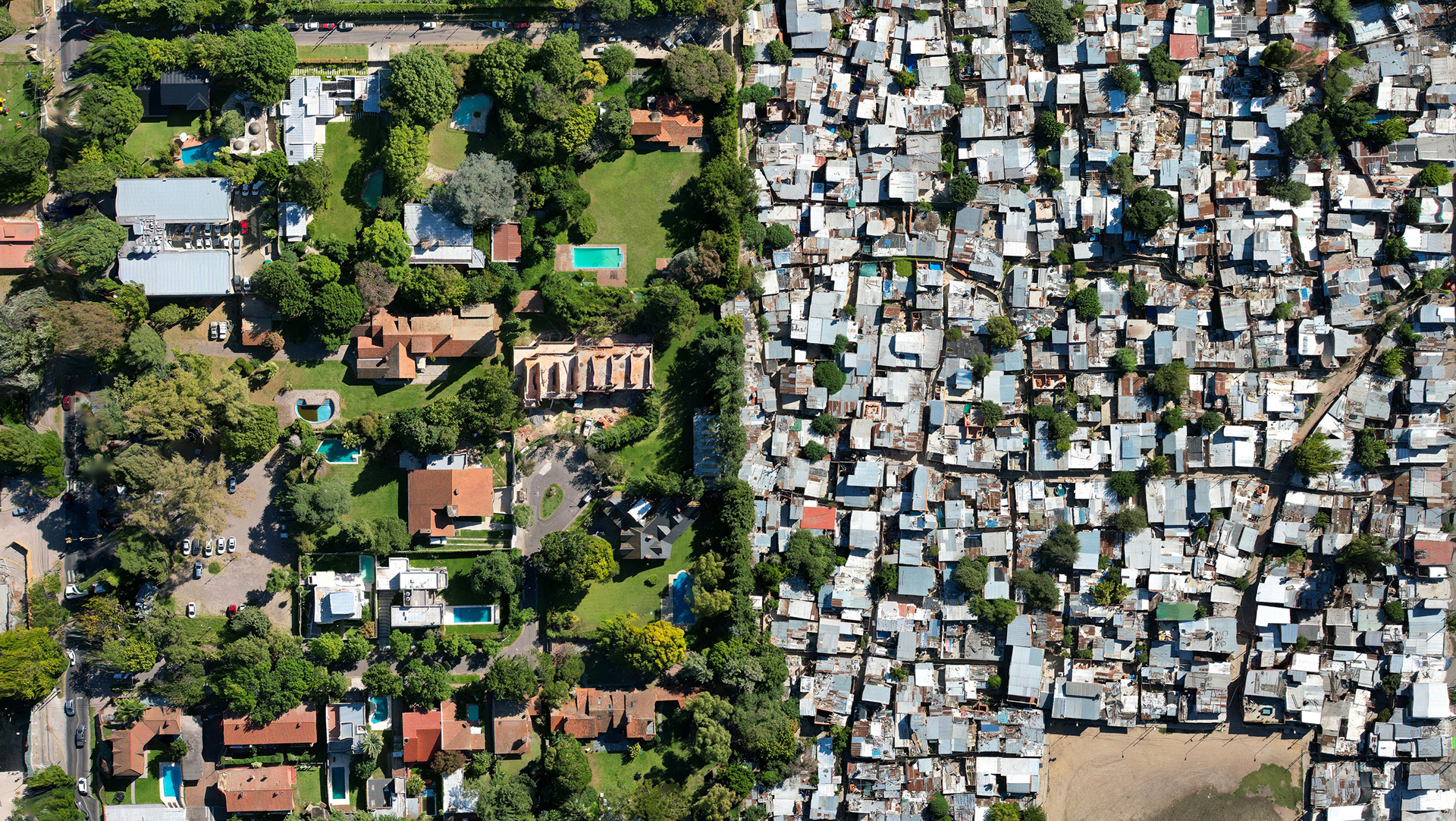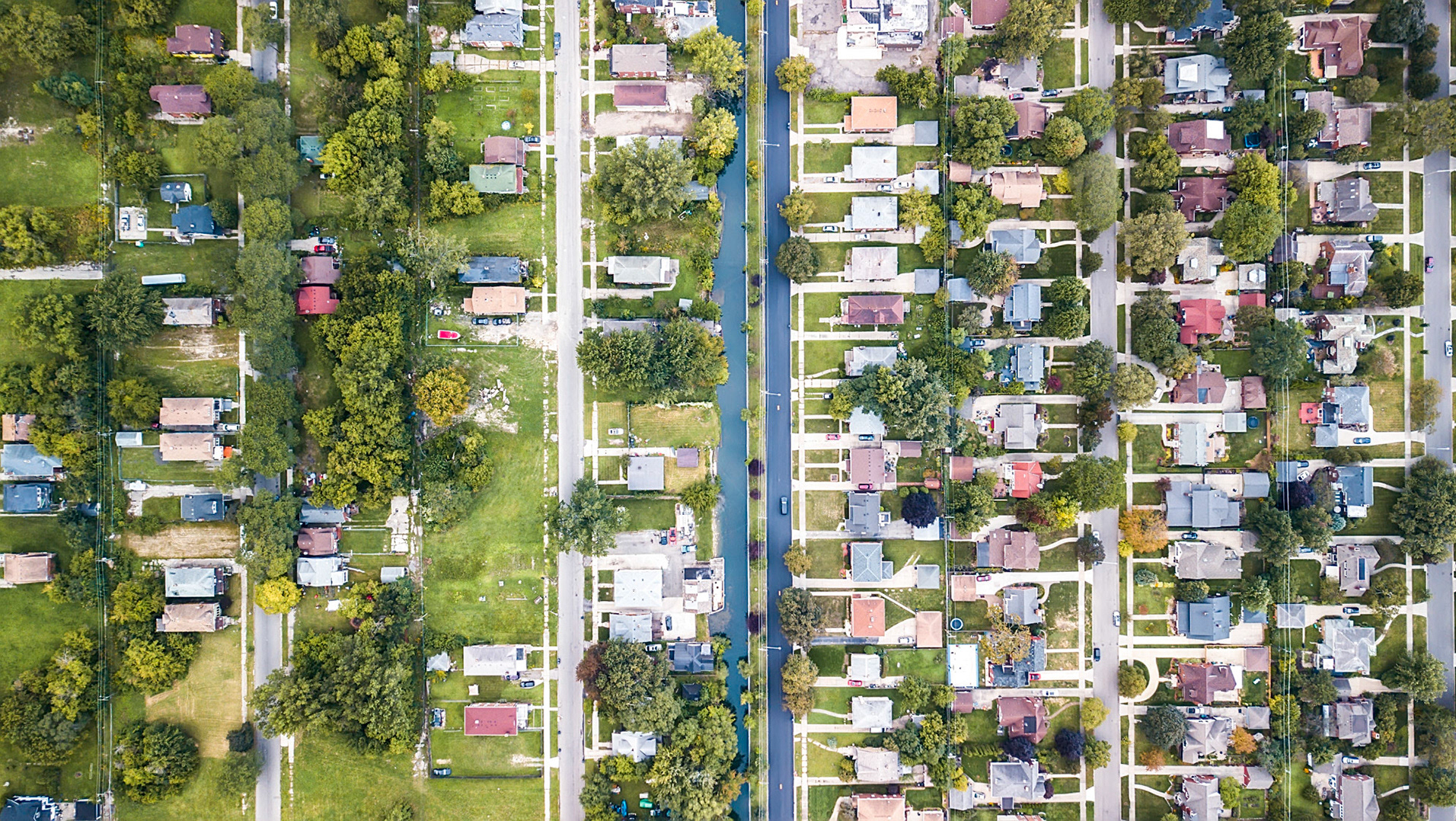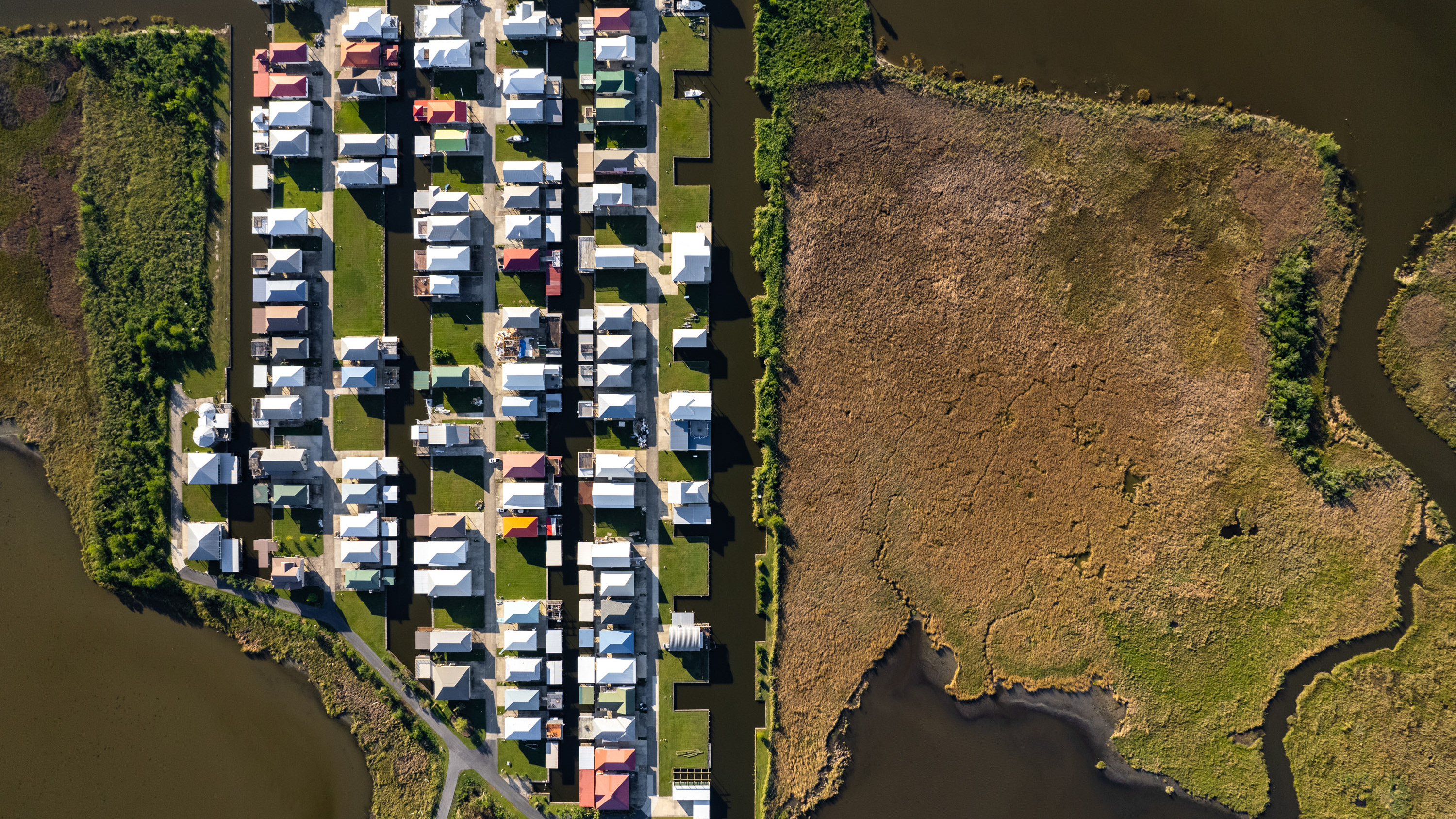The "most famous photo" of inequality in Brazil: Paraisopolis, São Paulo.
The favela of Cantagalo overlooks some of the highest price real estate in Brazil, in Rio de Janeiro's famous south zone.
Open pit mining next to the town of Nova Lima in Minas Gerais. Several dam failures in the province have released tons of toxic mud into river systems and killed hundreds.
A rainstorm in Manaus moves over the boundary between the Amazon rainforest and the city. Extreme deforestation has rang alarm bells that one of the world's "lungs" may be collapsing.
Indigenous people from across Brazil march to the National Congress building, in Brasilia. Over 7,000 people came to this year’s Acampamento Terra Livre (ATL - “Free Earth Camp”), the largest mobilization of indigenous people in Brazil, with the stated aims to “promote good living, reforest minds and indigenize politics”. The ATL spawned the Articulation of Indigenous Peoples of Brazil (APIB), a bottom-up organization which brings together regional Indigenous organizations in solidarity, with the goals of articulating Indigenous demands, strengthening the unity of the people, and mobilizing against threats and aggressions against Indigenous rights.
One of the main axes of resistance by the Indigenous community is to defend the right to demarcate their traditional lands, currently a contested topic being decided in Brazilian courts. The “Marco Temporal”, or decision in which Indigenous people will only have the right to claim land in which they occupied at the moment of the constitution coming into force (Oct 5, 1988), is highly disputed by APIB and virtually every Indigenous group. Ruralist and agro-business interests however, including the President and his policies, have lobbied hard to support the measure, which would strip Indigenous groups of the right to campaign to legally repossess lands that were taken from them pre-1988.
"Cracolândia" is an open-air drug zone in São Paulo, tolerated and even somewhat "managed" by the city government. The thinking is to provide a zone for the use of drugs near the city's main train station, with police stationed at every exit to contain the sprawl. Cracolândia moves around, however, popping up on different streets, spilling into adjacent neighborhoods, and reminding Paulistas that this megacity still has series challenges to tackle.
Huge new sections of the cemetery in Manaus were opened during COVID to handle the influx of people dying from the virus. Manaus briefly entered the world news cycle as a horror story unfolded in January 2021, when health services ran out of oxygen, leading dozens of people to essentially suffocate to death. The health system's failure was seen as a result of then-President Jair Bolsanaro's refusal to take COVID seriously.
This empty lot is where a fire broke out, causing a 24-story building to collapse in São Paulo in 2018. Inside were up to 428 people living in a "squat", a type of illegal encampment inside abandoned buildings. Housing is at a shortage in this megacity, forcing residents who don't want to live in the periphery of the city to resort to dangerous and unsafe living conditions such as these. At last count, 49 people were still missing.
Ceilândia, outside of Brasília.
When Brasilia was built in the in the late 1950s, the modernist planned capital of Brazil required tens of thousands of laborers. However, when the city officially opened in 1960, this "exemplary city" had a problem. These laborers did not fit the image of an intentional, orderly and white city that the military dictatorship envisioned as their capital.
Beginning in the late 1960s, upwards of 80,000 people were persuaded to move, some of them forcibly, to a new district approximately 10km from the center of Brasilia. The state company responsible for this move was known as Campanha de Erradicação das Invasões (Company for the Eradication of Invaders), or CEI...which led the residents to coin the new district "Ceilândia".
Today, it’s the largest district in the Federal District region, many of them from the northeast, black, and distinctly removed from the centers of commerce and power many kilometers away. Despite this, Ceilândia is a powerhouse of culture, especially hip hop. “This city is a great mother”, local rapper Japão told me. “Our slang words are very confused. Why? Because we always mixed them up. This is the Carioca way, understood with the slang of the Northeasterner, who came to build Brasília.”
The very first favela established in Rio is called the Morro de Providência, shown here reflected in the façade of an office tower. It was a refuge for returning black soldiers, who named it after an irritating bush found in the northeast of the country - the favela. Today, favelas are proudly part of the city’s landscape, centers of culture and innovation. However, as the city is dynamically growing, with developments going up and tourists beginning to pour back into the city’s famous south zone, many favela residents feel abandoned by the government, and all but completely shut out of the city’s privileged areas.
Orixas in Salvador, Brazil.
Afro-Brazilian religions have millions of followers in Brazil, with orixas (or deities) playing an important connective role between the spiritual and the corporal world. In the center of Salvador, the most important city to Afro-Brazilian culture and history, these orixas appear to float on top of the water, surrounded by favelas on the south and east and the World Cup soccer stadium to the north. Afro-Brazilian religions such as Candomblé and Umbanda are experiencing a sharp rise in attacks by evangelical Christian organizations, spurred on by a climate of rising nationalism and right-wing ideologies. These groups are emboldened by President Bolsonaro and his government’s statements and policies, adding to the climate of fear and racism experienced by Black and northeastern people throughout the country.
Data from the Ministry of Women, Family and Human Rights (MMFDH) indicate that in 2021 alone there were 586 complaints of religious intolerance, which is equivalent to an increase of about 141% compared to 2020, when there were 243. “Christian, neo-Pentecostal denominations need to have a demon, need to have an enemy to fight.”, writes Pai Jorge, the general coordinator of the Amazon Articulation of Traditional Peoples and Communities of Terreiro de Matriz Africana (Aratrama). “What Brazil is experiencing today is a declared war with a religious background, and Bolsonaro as President of the Republic is the exponent of this religious war.”
Rocinha, one of Rio's densest and most dangerous favelas, has spread over the top of the mountain and down into prosperous Leblón.
Favela houses glow orange in the sun during a break in the clouds over São Paulo.
In January 2019 a wall of mud swept down the valley below a retaining dam near the town of Brumadinho, killing over 260 people. The dam was owned by Vale, the largest company in Latin America and one of the largest mining companies in the world.
Far from being an isolated event, this happened just three years after another dam burst only 50km away in Mariana, then considered Brazil’s worst environmental disaster, and currently being contested in the UK in the largest class-action suit ever to take place in that country. Vale, to this day, continues to operate dams which are unreliable, and continues to mine an area which already suffers from high rates of illnesses and environmental degradation.
Mining towns like Tejuco have actually increased their dependence on mining companies since the Brumadinho and Mariana dam failures. The environmental and economic catastrophe from living next to gold mines means that they are now bound in a type of symbiosis of survival.
The wall of mud from the Brumadinho dam break swept over a guesthouse located less than a kilometer downstream, which memorialized the event with a series of crosses, one for each guest who died, on the hillside just above the path of the mud.
Santa Marta, Rio de Janeiro. One of the more "famous" favelas, Santa Marta even hosted a music video for Michael Jackson (They Don't Really Care About Us, 1996). Now, the unfinished housing projects, the ailing tramway, and the feeble drainage system are examples in which infrastructure collapses without state assistance. The local neighborhood association, the office within the favela which liaises with the city government, is seen as corrupt and inefficient. The police, widely loathed and mistrusted, rarely enter the favela and then only to “shoot to kill”. It's impossible to enter with a camera (or drone) without the approval of the drug gangs. The resulting vacuum has left the community to fend for itself, but also created a vibrant, fiercely proud, and cohesive culture of creativity.
“Maintenance of the community is directly linked to political power and political will", Sheila Maria Gonçalves de Souza told me, a community leader inside Santa Marta. "And why can’t we do maintenance? Because most of that decision making is top-down. Because of that, what happens? We don’t participate in these decision-making processes, so we do not reap the result of these decision-making processes.”
Sunset over the hills including the favela Morro de Papagaio in Belo Horizonte.
Even the term favela itself is being reclaimed by residents, and especially the younger generation, who use the term “favelado/favelada” proudly. The narrative of favelas as vital and unique (not to mention important) centers of cultural production and innovation is one that local leaders and entrepreneurs are quick to highlight.
“People in positions of social risk do what we call ‘entrepreneurship out of necessity’”, explains Tatiana Silva,
co-Founder of Fa.Vela, a startup which began in a favela in Belo Horizonte.
São Paulo, Brazil.
Tatuapé, São Paulo.
Morumbi next to Paraisopolis, São Paulo.
Three iconic apartment buildings at the center of Brazilian inequality in São Paulo.
The Occupy 9 do Julho (9th of July), perhaps one of the most famous Occupy movements in the city of São Paulo, is located in one of the most expensive neighborhoods near the city center, and hosts around 124 families since 2016. Housing is at a premium in highly centralized São Paulo, and many people need to travel on overburdened public transit hours each way from the peripheral parts of the city to work.
The majority of residents are not asking for free places or shelters, but rather the right to the city: fair conditions to finance a house, a fair monthly pay and rent that a worker can afford, and to have more equal access to valuable places of the city. With a small textile cooperative, a community garden and open weekly organic lunches every Sunday, MSTC (Movimento Sem-Teto do Centro, or Homeless Movement of the City Center) works to create dialogues with different movements, collectives, academic groups and society in general. Carmen Silva, the main leader, is now running for the São Paulo
state parliament.
An Occupied building in São Paulo, just off the famous Avenida Paulista. The graffiti on the outside of the building is a typical style of “pixação”, which is a unique form of highly stylized protest/symbolic writing found all over the city. Pixação is especially prevalent and popular in São Paulo and used for diverse reasons: as a type
of calling card, communication, or even protest art. Pixadores use their skill, climbing prowess, and daring to reach the highest and most dangerous locations in a city famous for its horizon full
of tall buildings.
Gilmar and Adysson, friends living in the Occupy Mauá in central São Paulo, look down at the festivities for the 15th anniversary of the Occupy’s founding. The building, which used to be a hotel, fell into disrepair and was abandoned after the original owner died, leaving the family with an unrecoverable debt in unpaid city taxes. Today, it is one of the most successful occupies in the city, with over 200 families (and over 1,000 people) living in an intentional, organized community inside its walls.
Occupies are part of a series of vital social movements which work to provide safe, dignified housing in a city that lacks 360,000 houses and where many people take hours to commute from the peripheral areas. In Mauá, the spirit of resistance and political lineage is strong, with a large mural depicting Maria Carolina de Jesus in the entrance (a famous resident of the periphery, a black woman who wrote eloquently about her experience in the favela in mid-20th century São Paulo) and memorials to the occupation itself and to Marielle Franco. All the leaders here are Black, and the majority are women. There is a strong connection with the arts, and in particular, graffiti, and the interior of the space is covered in memorials, political slogans, and other artwork.
The largest port in Latin America, Santos, is surrounded by informal homes on stilts extending out over the water called palafitas.
Fishermen in Santos walk out almost a kilometer on this rail bridge to make their catch.
The Jurujuba Yacht Club offers accommodation and berthing slips for sailors in its strategic location in Guanabara Bay. Next to it, across a narrow fence, sits a traditional fishing colony.
The Port of Santos, the largest in Latin America.
The traditional lands of the Guaraní people, inside the city limits of São Paulo, is technically protected land in the form of both the Jaraguá aldeia and Jaraguá State Park. But the insatiable appetite of a city with 22 million people to grow and expand its low-cost housing means that there is constant pressure from developers, and also semi-legal low-income housing projects. The relationship between the environmentally protected areas (the park) and the Guaraní community is complicated by the fact that a large part of this historical and sacred land is off-limits to them.
The community itself is proscribed to 8 square hectares, with little space to farm and engage with the forest in a traditional way. New communities that have been established since the park’s inception, are at risk of being seized dependent on the outcomes of the Marco Temporal case working its way through the legal system (and a major driver of the ATL event and the APIB movement). This isn’t limited to Jaraguá - the Guaraní inhabit the most densely populated section of the country, a forest which has been decimated by deforestation and urbanization. When asked if he saw the encroachment by favelas onto park land as a fundamentally antagonistic relationship, Daví, one of the leaders of the Jaraguá community, responded “no”. The Guaraní see both communities as participants striving against the state in the quest for decency and good living.
Separation in Guarujá, in São Paulo state.
Vila Autódromo, at the site of the 2016 Rio Olympics.
Vila Autódromo has 20 houses today, down from several thousands inhabitants in the early 2000s.
Apartment buildings constructed for the 2016 Olympics sit colorfully alongside the Lagoa da Tijuca, opposite a sprawling favela.
Accusations of corruption and nepotism have dogged Rio developers for years, and the 2014 World Cup and 2016 Olympics were at the top of the list for land grabs and power plays. Multiple prominent politicians have been jailed or accused of corruption in the past few years, including the Mayor, in December 2020.
Copacabana beach at sunset.
Differences in housing in Salvador, Brazil.
An informal recycler carrying aluminum cans on Copacabana Beach, Rio de Janeiro.
A quilombo, or autonomous community of free slaves, still exists amongst the opulence of the Lagoa neighborhood in Rio's south zone.
The first quilombos emerged in the context of expansion of the colonial economic activity of sugar cane in Northeast Brazil, with resistance as a basic characteristic. Most can be found today in Bahia and Maranhão states, although the most famous was called Quilombo dos Palmares, and was located in present-day Alagoas. It was here that capoeira was said to have been first arisen, and the iconography of this powerful and large “Free-slave community” became a symbol of African resistance.
In Rio there are very few quilombos, however this one (the three buildings in the center of the image) is called Quilombo Sacopã and is located right in the middle of one of the wealthiest neighborhoods in Rio (Lagoa). Surrounded by mansions and luxury high-rise buildings, several families continue to live here and resist efforts to buy them out (there is a great interview with José Luiz Pinto, who can trace his lineage back 6 generations, here.
Thanks to the Brazilian Constitution, families living in quilombos are guaranteed the title to that land, meaning that for now, the 32 residents of Quilombo Sacopã and others are secure. There is a growing sense that Brazil is beginning to deal with its history as part of the Atlantic slave trade, examples being a new slave trade museum under construction in Rio and a Black Awareness Day holiday signed into law in 2011. Many feel, however, that it is well past the time for the country to fully account for being the number one destination for African slaves in the Americas, numbering well over 5 million (2 million were sent to the port of Rio alone) Moreover, Brazil’s ethnic geography is vast and while progress is happening in some areas of racial justice, others are notably sliding backwards (treatment of indigenous people in the Amazon, for example).
The Sacopá and Peixoto neighborhoods, near Copacabana Beach.
The Sacopá Quilombo is to the right in the photo (blue tarps).
The Moinho favela is the last favela inside the central district in São Paulo. It sits sandwiched between two train tracks.
Salvador, Brazil.
Santos, Brazil.
Itanhangá Golf Estate, Rio de Janeiro.
Lapa, Rio de Janeiro.
Belo Horizonte is famous for its "beautiful horizon", due to the many rolling hills surrounding this mining town.
A traditional fishing colony sits underneath skyscrapers in Salvador, on Brazil's northeast coast.
Copacabana, Rio de Janeiro.
Salvador, Bahia.
A Porsche dealership next to a favela, Belo Horizonte.
The famous Santa Marta favela, Rio de Janeiro.
Leme Beach is a lively mix of favela and affluence, that would probably not work in any other city in the world. Here, it's normal - and by and large, people get along.
Morro de Vidigal is a historic favela which encircles the luxury Sheraton Resort hotel like a set of pincers. On the opposite side of this mountain is the huge favela of Rocinha.
Rocinha, perhaps Latin America's most famous favela, sits on a steep mountainside with Rio's famous south zone in the background.

